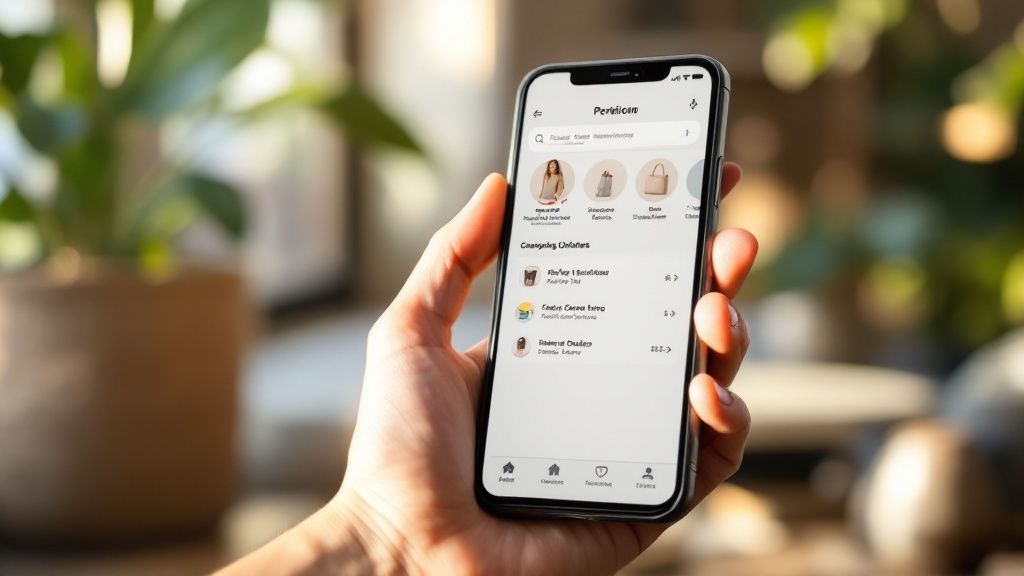Online Shopping Personalization: Proven Tactics
April 10, 2025

Why Traditional Personalization Is Failing Your Customers

Let's be honest: much of what's presented as online shopping personalization today feels impersonal and often misses the mark. Instead of feeling valued, customers are frequently bombarded with irrelevant product suggestions and generic messaging. This raises the question: why are so many retailers struggling to create truly personal experiences?
The Problem With Blanket Recommendations
One major issue is the over-reliance on basic product recommendations. Suggesting items simply because other customers bought them is a superficial approach. It's like recommending a sci-fi novel to everyone who buys a cookbook. The connection is weak, and the recommendation often feels random.
This approach ignores the individual shopper's unique needs and context. Truly personalized recommendations consider individual browsing history, past purchases, and expressed preferences.
Ignoring the Bigger Picture
Traditional personalization often focuses narrowly on product suggestions, neglecting the wider customer journey. For example, a returning customer might be greeted with the same generic welcome message as a first-time visitor.
This lack of contextual awareness creates a disconnect and diminishes the feeling of a truly personalized experience. True online shopping personalization recognizes and responds to the customer's current needs and past interactions. A returning customer should be acknowledged and offered a tailored experience.
The Psychology of True Personalization
Effective personalization goes beyond simply showing the right products. It leverages psychological principles to create a sense of connection and understanding. This involves considering factors like customer motivation, individual preferences, and even emotional state.
For example, a shopper browsing for a gift will have different needs than someone replenishing a household staple. Addressing these underlying psychological drivers is key to crafting resonant personalized experiences.
Additionally, personalization in e-commerce has become a key driver for both customer satisfaction and business success. In fact, 60% of consumers are more likely to become repeat customers after a personalized shopping experience. This trend is especially important as the global e-commerce market continues to grow rapidly, projected to reach $6.49 trillion by 2029. Explore this topic further: Find more detailed statistics here.
The Need for a New Approach
These shortcomings highlight the need for a fundamental shift in how retailers approach online shopping personalization. Moving beyond basic product recommendations and generic messaging requires a deeper understanding of individual customer needs, motivations, and the entire customer journey.
This means investing in technologies and strategies that enable truly dynamic and contextual experiences. This shift will be key to unlocking the true potential of personalization and fostering lasting customer loyalty. By focusing on the individual, retailers can create shopping experiences that resonate and build strong customer relationships.
The Real Economic Impact Beyond the Hype

Beyond the buzz, online shopping personalization delivers a tangible return on investment. This isn't about creating a pleasant shopping experience; it's about driving revenue and building a thriving business. Let's explore the financial benefits.
From Browsing To Buying: Impact on Conversions
Personalization significantly impacts how customers shop online, especially when it comes to converting browsers into buyers. Presenting relevant product recommendations and targeted offers can dramatically reduce cart abandonment rates, sometimes by as much as 30%. This directly translates to more sales and higher revenue.
Imagine a customer leaving running shoes in their online cart. A personalized email reminding them about the shoes and offering a small discount might be the encouragement they need to complete the purchase.
Beyond The Sale: Fostering Customer Loyalty
Personalization's advantages go beyond the initial sale. Nurturing customer relationships through tailored communications and relevant product suggestions cultivates customer loyalty. Loyal customers tend to make repeat purchases, which increases customer lifetime value.
This emphasizes that personalization is not a short-term tactic, but a long-term investment. A personalized loyalty program can incentivize repeat business and strengthen customer relationships.
To better understand the revenue implications of various personalization strategies, let's take a look at the table below:
To better understand the revenue implications of various personalization strategies, let's take a look at the table below:
Revenue Impact of Personalization Strategies
This table compares different personalization approaches and their typical impact on key business metrics.
| Personalization Strategy | Avg. Revenue Increase | Customer Retention Impact | Implementation Complexity |
|---|---|---|---|
| Basic product recommendations | 5-10% | Low | Low |
| Personalized email marketing | 10-15% | Medium | Medium |
| Dynamic website content | 15-20% | High | High |
| Omnichannel personalization | 20-25% | Very High | Very High |
As you can see, the more sophisticated the personalization strategy, the greater the potential impact on revenue and customer retention. However, more complex strategies also require more resources and expertise to implement. Choose the approach that aligns best with your business goals and capabilities.
The financial impact of personalization is substantial, driving revenue growth and boosting customer retention. Businesses that excel at personalization earn approximately 40% more revenue from these initiatives than their slower-growing competitors. Furthermore, personalization is more than just a marketing tool; it fundamentally changes how businesses operate. For a deeper dive into the economic impact of personalization, read the full research here.
Measuring The ROI of Personalization
Measuring the return on investment (ROI) of online shopping personalization requires tracking key metrics. These metrics might include conversion rates, average order value, customer lifetime value, and customer retention rates. By monitoring these metrics, businesses can evaluate the effectiveness of their strategies and make data-driven adjustments.
It's also vital to align personalization efforts with overall business objectives. This ensures that these initiatives contribute to the company's broader financial goals. Prioritizing approaches that align with your specific business model is essential for maximizing ROI. This focused approach directs resources effectively and delivers meaningful results.
Behind The Scenes: Technologies That Actually Work

Effective online shopping personalization isn't some mysterious force; it's the product of powerful technologies working together. This section explores the core components that drive truly personalized experiences.
Recommendation Engines: Predicting Customer Desires
At the heart of personalized online shopping are recommendation engines. These algorithms analyze large datasets, from browsing history and past purchases to product ratings and reviews. They use this information to predict what a customer might want next. Imagine a knowledgeable sales associate who anticipates your needs based on your previous behavior.
Not all recommendation engines are the same. Some offer simple product suggestions based on general popularity or items frequently bought together. More advanced engines use machine learning to provide highly personalized recommendations.
Real-Time Personalization: Adapting On The Fly
Real-time personalization systems take this concept a step further. They analyze customer behavior as it happens, adjusting website content and promotions in a matter of seconds. For instance, if a customer frequently views products in a particular category, the website can dynamically display related offers or adjust the navigation to highlight that category.
This level of responsiveness creates a more engaging and relevant experience for shoppers. It relies on powerful technology that processes and reacts to data instantly. This ability to personalize dynamically boosts customer engagement and can heavily influence purchasing decisions.
Customer Data Platforms: Building Unified Shopper Profiles
Customer data platforms (CDPs) play a critical role in creating a single, unified view of each customer. CDPs gather and integrate data from various sources, like website activity, email interactions, CRM systems, and even offline interactions. This unified profile provides a complete picture of each shopper.
Think of a CDP as a central hub for all customer information. This consolidated view empowers businesses to deliver personalized experiences at every point of contact, leading to more targeted and effective online shopping personalization.
Evaluating and Implementing The Right Technologies
Selecting the right technologies for your business requires careful thought. Factors such as budget, technical expertise, and overall business goals all play a role. The good news is there are solutions for businesses of all sizes and budgets.
Start by pinpointing your specific personalization needs. Then, evaluate vendors based on their features and track record. Building a technology roadmap that aligns with your personalization maturity is key for sustainable growth.
Key Technologies For Personalization
| Technology | Description | Benefits |
|---|---|---|
| Recommendation Engines | Analyze data to predict product preferences | Increased sales, improved customer engagement |
| Real-Time Personalization Systems | Adapt website content dynamically | Enhanced user experience, higher conversion rates |
| Customer Data Platforms (CDPs) | Create unified customer profiles | More targeted marketing, improved customer understanding |
Begin with fundamental technologies, like basic recommendation engines, and gradually add more advanced solutions as your needs evolve. This incremental approach enables controlled growth and maximizes your personalization efforts. By understanding the technologies behind online shopping personalization, you can make smart decisions about which solutions best fit your business. This strategic approach allows you to maximize your ROI and create truly resonant experiences for your customers. For more tips on enhancing customer engagement through email, see our guide on effective email marketing strategies.
Building a Data Strategy That Doesn't Overwhelm You

Many retailers find themselves surrounded by data, yet struggle to extract useful insights. Effective online shopping personalization requires a strategic approach. This involves focusing on the most relevant data and using it efficiently to avoid an unwieldy data strategy.
Identifying the Right Data Points
Not all data is equally valuable. For personalization, some data points carry more weight than others. While demographic data offers some insights, behavioral data provides a much richer understanding of individual customer preferences. This includes tracking browsing history, purchase patterns, and interactions with your website and marketing materials. Tools like ecommerce chatbots can collect valuable real-time data about customer preferences and needs.
For example, knowing a customer frequently buys organic products is more insightful than simply knowing their age. This knowledge allows you to present product recommendations and offers tailored to their specific interests.
Ethical Data Collection and Consumer Trust
Collecting data ethically is crucial. Transparency and open communication with customers about data usage are essential for building trust. Give customers control over their data and ensure compliance with privacy regulations, such as GDPR and CCPA. This fosters confidence and strengthens long-term relationships.
This transparent approach not only builds trust, but also empowers customers to actively participate in shaping their personalized experiences. They can choose which data collection practices they participate in, ensuring they retain control over their information.
Maintaining Data Quality Without a Data Science Team
Maintaining data quality is a key concern for businesses. High data quality ensures accurate and reliable results. However, this doesn't necessitate a large team of data scientists. Implementing simple checks and validation rules during data collection can significantly improve accuracy. Regularly auditing your data for inconsistencies and errors is another cost-effective way to maintain high data quality.
For instance, using drop-down menus instead of free-text fields for specific information can greatly reduce errors. This simple practice enhances data quality and minimizes the need for manual cleaning.
Building Effective Customer Profiles
Combining different data types creates robust customer profiles. These profiles should offer a complete picture of each customer, encompassing their purchase history, browsing behavior, and stated preferences. This comprehensive view informs and shapes the entire online shopping experience. Resources like this article on customer segmentation strategies can provide further insights.
This approach allows businesses to provide personalized product recommendations, targeted promotions, and website content tailored to individual needs and preferences. This creates a more engaging and relevant shopping experience.
Essential Customer Data Types for Personalization
The following table outlines different categories of customer data and demonstrates how each contributes to effective personalization.
| Data Category | Examples | Personalization Applications | Collection Methods |
|---|---|---|---|
| Behavioral Data | Browsing history, Purchase history, Product interactions | Personalized product recommendations, Targeted promotions | Website tracking, Purchase history analysis |
| Demographic Data | Age, Location, Gender | Tailored marketing messages, Location-based offers | Customer registration, Surveys |
| Preference Data | Product ratings, Reviews, Wishlist items | Curated product selections, Personalized content | Product feedback forms, Wishlist functionality |
By focusing on these key data types, businesses can offer truly helpful experiences that resonate with their customers. This targeted approach enables meaningful online shopping personalization without excessive complexity or extensive resources.
Creating Connected Experiences That Shoppers Notice
Effective online shopping personalization isn't about isolated tactics. Instead, it's about creating a consistent, personalized experience across every touchpoint. Think of it as a subtle, yet impactful element that enhances the entire customer journey.
Connecting The Dots Across Channels
Imagine a customer adds an item to their online shopping cart on their desktop but doesn't purchase it. Later, they visit your store on their mobile device. Instead of generic product suggestions, they see a personalized message reminding them about the item in their cart, perhaps with a small incentive to complete the purchase. This cross-channel personalization acknowledges and responds to the customer's individual journey. You might be interested in: How to master eCommerce personalization with practical examples.
Shoppers move seamlessly between channels—website, email, social media, and even physical stores. Your personalization strategies must reflect this interconnected reality.
Personalization Beyond Product Recommendations
While product recommendations are important, personalization goes beyond simply suggesting "what to buy next." It encompasses every aspect of the online shopping experience, from website navigation and search results to email campaigns and offline interactions.
Personalized search results, for example, can prioritize products based on individual preferences and browsing history. Similarly, website navigation can dynamically adapt to highlight relevant product categories for each shopper.
The Power of Contextual Personalization
Effective personalization is contextually relevant. A customer searching for a gift has different needs than someone buying everyday essentials. Recognizing and responding to these different contexts is crucial for creating resonant experiences.
A shopper browsing for a gift might appreciate gift guides or suggestions for related items. A repeat customer, however, might prefer a streamlined checkout process and personalized order updates. This tailored approach ensures that your online shopping personalization efforts meet the specific needs of each shopper at each touchpoint.
Creating Seamless Experiences That Customers Remember
Leading brands use personalization to solve specific customer problems and eliminate friction points. Imagine a customer frequently searching for a hard-to-find item. Personalizing their experience might involve proactively notifying them when the item is back in stock. These small gestures create memorable experiences that shoppers value.
This goes beyond simply increasing conversions or average order value. It's about building loyalty and turning one-time shoppers into brand advocates. By focusing on connected, contextual experiences, you can foster deeper customer relationships and unlock the true power of online shopping personalization.
Solving the Real Challenges Nobody Talks About
Implementing effective online shopping personalization can be complex. Many retailers encounter obstacles that hinder their efforts. This section addresses these real-world challenges, offering practical solutions and actionable strategies.
Navigating Privacy Regulations
One of the biggest hurdles is navigating privacy regulations. Customer privacy and data security are paramount. Regulations like the GDPR and CCPA require transparency about data collection and give customers control over their data.
Addressing these concerns builds trust and demonstrates ethical data handling. Communicate your data usage policies clearly and provide options for managing data preferences. This transparency strengthens customer relationships.
Breaking Down Internal Silos
Another challenge is breaking down internal silos. Personalization requires collaboration across departments, from marketing and IT to customer service and sales. These departments often have different priorities and systems, making data sharing and coordinated action difficult.
Marketing might collect data through email campaigns, while customer service gathers information from support interactions. Integrating this data into a unified view is essential for effective personalization. This means breaking down departmental barriers and fostering collaboration.
Scaling Personalization With Limited Resources
Many retailers, especially smaller businesses, struggle to scale personalization with limited resources. Implementing advanced technologies and strategies can be costly and require expertise.
Start small and scale gradually. Focus on high-impact areas like personalized product recommendations and targeted email campaigns. As your business grows, incorporate more advanced technologies and expand your efforts incrementally. This approach yields meaningful results without overspending.
Measuring True ROI and Securing Buy-In
Demonstrating the return on investment (ROI) of personalization is crucial for securing continued support. While personalized experiences can increase conversions and customer loyalty, quantifying these benefits can be challenging.
Track key metrics aligned with your business objectives. If your goal is to reduce cart abandonment, track the impact of personalized cart recovery emails. To increase customer lifetime value, monitor how personalized product recommendations affect repeat purchases. This data-driven approach justifies continued investment.
Balancing Automation With Human Oversight
While automation is essential for scaling personalization, maintaining human oversight is equally important. Algorithms can analyze data and make predictions, but they cannot replace human intuition and creativity.
Automated email campaigns can be effective, but they shouldn't entirely replace personalized messages from human marketers. This balance ensures authenticity and resonates with your audience. Combining automation with human understanding is key.
Identifying High-Impact Opportunities
Maximize your efforts by identifying opportunities with the greatest impact and least effort. This builds momentum and achieves early wins, securing buy-in for larger initiatives.
Personalized product recommendations on product pages can improve conversion rates. Personalizing email subject lines can increase open and click-through rates. Prioritizing these high-impact, low-effort opportunities demonstrates the value of personalization and encourages further investment.
Checkout Links can personalize your email marketing and boost conversions with shoppable links. Start your free trial today and discover the power of personalized email marketing.
 Checkout Links
Checkout Links



